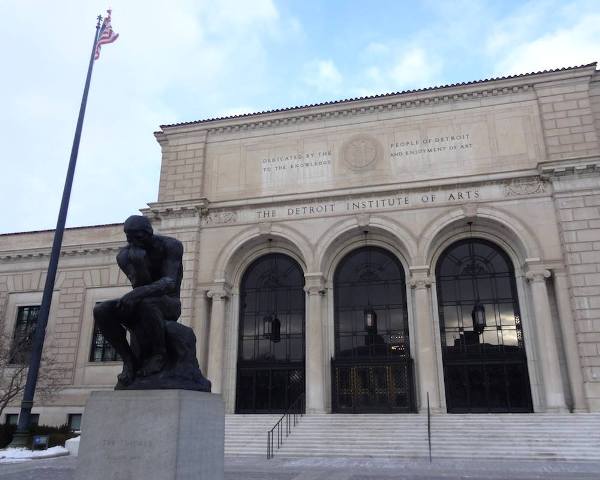Auctions
Art World Report Card: Did the Art World Fail the Detroit Institute of Arts?
Did the art world fail Detroit? Dali vs Picasso and artists vs auction houses, again.
Did the art world fail Detroit? Dali vs Picasso and artists vs auction houses, again.
Alexandra Peers


The Detroit Institute of Arts.
Photo: Benjamin Sutton.
Has the Art World Failed Detroit?
Detroit’s dynamism surprises me. The city has attracted so much bad press, and built up so many negative expectations, that when you finally see all the abandoned buildings it’s the thriving ones next to them that demand attention. Detroit’s bustling downtown is a shock.
Kevyn Orr began his tenure as emergency financial manager of Detroit a year ago. Soon after he began, he called in Christie’s to appraise a portion of the Detroit Institute of Arts collection with an eye towards a partial sale. Uproar ensued. Now a compromise has been worked out wherein foundations, the state and donors will give about $800 million to buy the municipally-linked museum its independence. That said, the city is in bankruptcy and nothing is set in stone.
I’ve been to Michigan a couple of times since the bankruptcy to see the Heidelberg Project neighborhood (recently and tragically damaged by suspicious fires), the ArtPrize in Grand Rapids, and the beleaguered DIA. And despite the hand-wringing that’s gone on about it all, a case can be made that the art world has failed Detroit. I mean this seriously. Consider the Grand Tourists, that subset of collectors, dealers, artists, and general gawkers who would (to steal from John Lithgow) cross the Alps for a free hot dog or, more aptly, drive five hours through the desert to see Prada Marfa—especially after one of its recurring visits from vandals.
It is my impression that this subset of visitor, if they are making their way to Michigan at all, aren’t seeing the state’s vibrant contemporary art scene and the city’s exceptional historic architecture. Instead, they come to ogle the DIA as an art world cautionary tale, i.e., “don’t let this happen to your municipal museum; restructure now.” It is art world rubbernecking. But that’s not the whole story here.
First and foremost the DIA is an outstanding museum. I did not expect to be Hermitage gob-smacked, but that’s what the DIA does to you. The Gauguin, the Bernini, the Caravaggio, the stained glass, the welcoming wall-eater murals by Diego Rivera. This really is a civic collection of great merit and it should not be missed. Wandering the galleries I noticed each room is titled with the name of an individual donor or family. But it is mostly institutional names behind the bailout, so there are likely some very rich people in this neck of the woods who should be ashamed of themselves.
Not everybody dropped the ball. Miami art collector Dennis Scholl, vice president of art at the Knight Foundation, one of the generous donors, told an Art Basel Miami Beach panel last December that he expects Detroit “to be the next Berlin.”
But where is the urgency in the arts community to develop programs, the kind of rallying-around that happened after Hurricane Katrina that could and should make that optimism a reality? To its credit, the Association of Art Museum Curators moved its annual meeting to Detroit this year. But what about moving the much-larger American Alliance of Museums 2016 convention to Detroit. How about a Creative Time extravaganza on Belle Isle? A hotel art fair or even—Art Basel Detroit?

Salvador Dali in 1939.
Photo: Carl Van Vechten. Via Wikimedia Commons.
Who Gets Top Billing?
It is rare that the name of a museum exhibition is a political hot potato. But it’s happening in Barcelona and St. Petersburg, Florida right now.
“We have been over the title [of the show] for the last two years about a thousand times,” says Bernardo Laniado-Romero, director of the Museu Picasso in Barcelona. In March 2015, the museum will open a show devoted to Salvador Dali and Pablo Picasso, pretty much the first recent one focused on just the two Spaniards, he says. But the show actually premieres at the Dali Museum in St. Petersburg, Florida, on November 18, 2014.
So which artist gets his name first in the exhibition title? In short who gets the top billing?
Splitting the difference, sort-of, the Dali Museum will open its show with a double-billed title: “Picasso/Dali, Dali/Picasso.” What a silly solution for an exhibition title, but I guess it works for the organizing venues.
As for the show itself, it is a surprisingly apposite pairing: Picasso, not always known as a warm supporter of younger artists, took his younger countryman under his wing after Joan Miro introduced them in the mid-1920s. “These are two artists who have been written about but their relationship has not been studied,” says the director of the Museu Picasso. Meanwhile, the director of the Dali Museum, Hank Hine, notes: “We think we know Picasso, we think we know Dali,” but the show “will add new knowledge.”
In Private
Whenever eBay, Sotheby’s, and Christie’s get together, something interesting is going on. The trio have united in lobbying against a proposed New York State bill that would pay royalties to artists whose work has sold at auction. But the bill, if passed, would likely drive trophy property to the auctioneers’ private sales departments, which would be legally restructured as independent dealerships, and thus not covered by the bill, insiders say. Lawyers for at least one house are already working on the paperwork.
Art World Report Card appears every Thursday on artnet news. Contact the author at [email protected]; Follow her on Twitter at @LoisLaneNY.